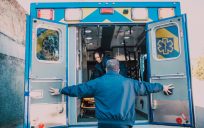![]()
The state of America’s infrastructure has been front and center lately. Recently, the American Society of Civil Engineers, which provides a report card each year, gave our roads a D rating. That may not be surprising considering 1 in 9 of our nation’s 607,380 bridges is rated as structurally deficient and that the average age of those bridges is 42 years old. The United States appears to be having a midlife crisis.
Fixing our roads, bridges, sewers, and transmission lines may seem an insurmountable task, but we can start by pinpointing areas most in need of upgrades. This begins by analyzing the current condition of our nation’s assets, where needs are greatest, and how we can identify the most strategic infrastructure investments to deliver the greatest benefit.
The first step is ensuring that information can be shared between every level of government, including the Presidential Administration, Congress, and the many state departments of transportation. Understanding the trade-offs between different investments ensures that money is delivered to make the greatest impact. Next, the ability to monitor the progress and performance of investments, as well as the ability to communicate these to the public is imperative.
In the case of electric transmission lines or pipelines, for instance, age isn’t the only determination of risk in failure. Consideration needs to be made for how well the system has been maintained over the years, where transmission lines run, and what transmission lines are exposed to. For example, exposure to salt contamination from coastal sea water and high winds, would likely make lines more vulnerable than those in less-exposed areas. Location matters and knowing where improvements are needed sooner rather than later helps serve communities and stretch tight budgets. How can we better understand where to invest improvement dollars smartly? Governments need to bring together information so it can be analyzed, understood, and used to drive action in communities and across the nation.
I’ve been inspired by recent launches of open data online portals—called hubs—to share information between organizations and individuals in their communities. Los Angeles and Long Beach have launched open websites where citizens, businesses, academics, and software developers can access data that is collected and maintained by the cities. These hubs take raw open data and present some of the city’s high-level issues and initiatives, such as trash pickup and pothole repair, through applications and crowdsourcing tools that citizens can engage with to provide feedback and help improve their neighborhoods.
These hubs are cornerstones for cities striving to become Smart Communities. Citizens who have better access to data and online tools for public collaboration are better equipped to prosper and work together on initiatives to make their cities better. When data is readily available, it is easy for cities and advocacy groups to launch solutions like road closure apps and polling locators with that data, almost instantaneously.
A great example of this is Waze, a free, crowdsourced traffic and navigation app that people like me use to navigate tough commuting conditions. The data Waze provides is also used by governments, and together, we can build intelligent transportation systems in our communities. Data feeds on traffic issues from citizens—a tree down across a lane, a road accident, or flooding in a busy intersection—can be merged with information in existing government enterprise systems. Emergency dispatch and street maintenance systems can take advantage of this real-time crowdsourced information to make communities operate smarter and safer.
Harnessing the power of citizen-sourced information in combination with government data streams allows for data driven decisions in the rebuilding of our nation’s infrastructure. This location-based information is a critical linchpin for any efforts around improving our nation’s roads, bridges, sewers and transmission lines. In my opinion, enabling citizens to stay updated and involved in the infrastructure investments in their communities creates digital citizen engagement, and this is where the rubber meets the road.
Christian Carlson is part of the GovLoop Featured Blogger program, where we feature blog posts by government voices from all across the country (and world!). To see more Featured Blogger posts, click here.





Leave a Reply
You must be logged in to post a comment.